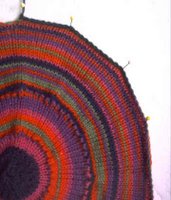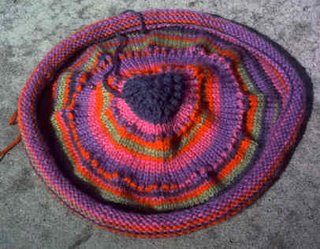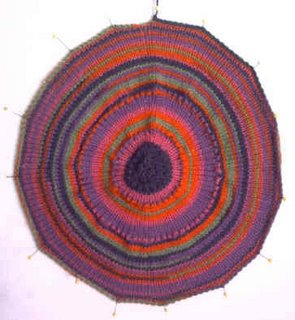Circles Round III -- Time for pi
 When I wrote that the pi example was at 144 stitches on round 22 I mistyped and should have said round 22 of plain knitting with 144 stitches on the needle.
When I wrote that the pi example was at 144 stitches on round 22 I mistyped and should have said round 22 of plain knitting with 144 stitches on the needle.The pi shawl is not as dependent on the number of stitches you begin with or how you arrange the increases. That's what makes it so simple and yet effective.
EZ's pi shawl:
Cast on 9 stitches divide evenly onto three needles, join, do not twist, knit with a fourth needle.
Round 1: knit
Round 2: (YO, K1)3x on each needle (9 times total) = 18 stitches 6 per needle
Knit 3 rounds plain
Round 6: (YO, K1)6x on each needle (18 times total) =36 stitches 12 per needle
Knit 6 rounds plain
Round 13: (YO, K1)12x on each needle (36 times total) = 72 stitches 24 per needle
Knit 12 rounds plain
Round 26: (YO, K1)24x on each needle (72 times total) = 144 stitches 48 per needle
Knit 24 rounds plain Round 51: (YO, K1)48x on each needle (144 times total) = 288 stitches 96 per needle
Continue as established doubling the total number of stitches in each increase round and doubling the number of plain rounds between the increase rounds.
With 24 rounds of stocking stitch, I am not surprised that it curls up much more than the other circles but I was surprised that it really didn't want to lie flat without considerable coaxing.
 In addition to the pi shawl, EZ's Knitting Almanac describes the spoke shawl which she describes as being formed with double increases (YO, K1, YO) at seven points every 4th row. After a detour to discuss Mary Thomas's Disc Medallion we'll take a look at the spoke shawl.
In addition to the pi shawl, EZ's Knitting Almanac describes the spoke shawl which she describes as being formed with double increases (YO, K1, YO) at seven points every 4th row. After a detour to discuss Mary Thomas's Disc Medallion we'll take a look at the spoke shawl.


0 Comments:
Post a Comment
Subscribe to Post Comments [Atom]
<< Home